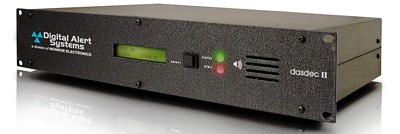DAS Eases Centralcasting EAS Compliance Issues

The Digital Alert Systems DASDEC II
SALT LAKE CITY
We run a centralcasting operation, servicing a total of seven stations, including our main on-air operation and that of KJZZ-TV here Salt Lake, as well as three stations in West Palm Beach, Fla., along with another operation in Providence, R.I., and one in St. George, Utah.
With these seven stations operating simultaneously in very different regions of the nation, we face many operational challenges. Among these is emergency alert management. This requires us to do sometime tricky juggling to ensure FCC alert compliance for both countrywide and regional alerts.
DASDEC TO THE RESCUE
To meet this need, we’ve brought on the DASDEC emergency alert monitoring system from Digital Alert Systems. With this system, a DASDEC encoder-decoder base unit installed at our KUTV station is connected via an IP network to DASDEC Intelligent Remote (DASDEC-IR) units at each of our stations nationwide. We’ve also integrated Digital Alert Systems’ optional multistation software for monitoring and management of all systems from our KUTV headquarters.
DASDEC and DASDEC-IR units have made our emergency alert situation easier than ever. We no longer need to manage encoder/decoders at each station—our main DASDEC acts as a host for all of our channels. And because each DASDEC-IR is a fully functional decoder, we know that emergency alerts will continue to be processed correctly, even in the unlikely event that the connection between the remote unit and host system is lost or broken.
REGION SPECIFIC
As we’re monitoring cross-country, we need to do filtering and send out only the alerts that are needed within each specific market. With this filtering process and the forwarding of only alerts that are applicable to a specific region, we’re able to avoid unnecessary program interruptions. Our DASDEC system offers many options and also gives us the level of control required to handle diverse emergency alert situations.
The DASDEC is really a big improvement over the old-style emergency alert systems. And what really shines is the system’s Web interface. This has proven to be vital in centralcasting situations, and really allows us to do a lot of things that we couldn’t do otherwise, especially when it comes to monitoring. I can test the radio reception on EAS units that are more than 2,000 miles distant. Just being able to listen to the radio reception of any unit within my office instead of in a noisy equipment room has been very helpful.
Software updates of the DASDEC units have been easy, and any issues we’ve had so far with the system have been speedily resolved. The DASDEC’s random automatic weekly tests make it a simple task to confirm that our systems are functioning correctly. Weekly and monthly email reports—which list all received, originated, and forwarded alerts for each broadcast market—also help me to ensure that we are meeting all FCC requirements. I’m able to scan through the reports and spot any issues quickly.
It’s really a good and comforting feeling to know that with our DASDEC system, we don’t have any compliance worries.
Scott Nielson is assistant director of engineering for KUTV, the CBS affiliate for the greater Salt Lake City area. He may be contacted at snielson@kutv2.com.
For additional information, contact Digital Alert Systems at 585-765-1155 or visit digitalalertsystems.com.
Get the TV Tech Newsletter
The professional video industry's #1 source for news, trends and product and tech information. Sign up below.
